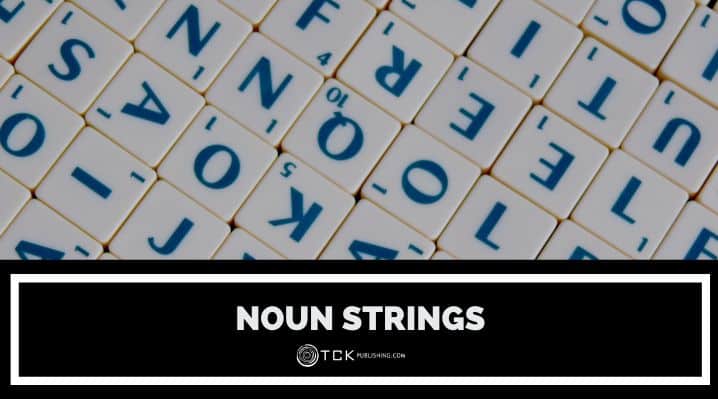
The more words there are in a sentence, the less its meaning is clear. You can have run-ons, garden paths, and now, noun strings—a bunch of words jammed together to mean one thing.
Noun strings are sneaky. They sound clever and important, but you often don’t realize how they mess up your writing. Let’s talk about why.
What are Noun Strings?
A noun string (or noun stack) happens when several nouns or adjectives are placed together to create a single term. Each word acts as a modifier, adding meaning to the last.
Some noun strings are straightforward. For example, “body mass index“, “wireless security system”, and “employee training program.” Two to three-word strings like these are common in English. You’ll often find them in business, academic, and technical writing.
The longer a noun string is, the harder it becomes to understand—especially if it includes unfamiliar words. It forces readers to pause and untangle how each word relates to the others. This disrupts comprehension and breaks the flow of reading. For example: “Quarterly Financial Report Data Analysis Findings Summary,” “Patient Medical History Record Management System,” and “Social Media Engagement Strategy Implementation Guide.”
Why Do Noun Strings Happen?
Noun strings don’t appear out of nowhere. Writers often use them for a few key reasons—intentional or accidental.
Many writers believe that longer, more complex phrases sound professional. But this often backfires, making your writing dense and hard to understand.
Another reason is the tendency to compress information. You stack words together instead of breaking ideas into smaller parts, assuming that your readers will understand.
And then there’s jargon. If you work in a technical field, you probably use noun-heavy phrases that make sense to insiders but confuse general readers.
Finally, you might not even realize noun strings are a problem. Without thinking about readability, it’s easy to overlook clearer alternatives.
Breaking a Noun String
Now that you know noun strings can weaken your writing, how do you fix them? Here are seven simple strategies:
Reorder the Sentence
Sometimes, simply changing the order of words makes a big difference. Noun strings often sound clunky. Reorder the sentence so the words flow more naturally.
- Instead of: Marketing campaign performance evaluation report
- Try: A report evaluating the performance of the marketing campaign.
Add Prepositions or Articles
Prepositions (of, for, in) and articles (a, an, the) help show relationships between words. This stops your readers from getting confused.
- Instead of: Software system security update implementation
- Try: The implementation of a security update for the software system
Split into Two Sentences
If a phrase or sentence feels too crowded, break it into two or more sentences. This way, you provide more information without making it hard to understand.
- Instead of: Employee training program development timeline adjustments
- Try: We are adjusting the timeline for developing the employee training program. Here’s what’s changing.
Use Verbs Instead of Nouns
Noun strings often happen because you turn verbs or adjectives into nouns. This is called nominalization. Changing them back makes sentences clearer.
- Instead of: New website feature rollout schedule
- Try: Here is the schedule for rolling out new website features.
Identify the Core Idea
Make sure the core idea of the sentence is in focus. Ask: What’s the main subject? What’s the action? Then rewrite for clarity.
- Instead of: New customer account registration system update
- Try: We’ve updated the system for registering new customer accounts.
Use Hyphens
Hyphens remove ambiguity by showing how specific words relate to each other.
- Instead of: Small business owner training program
- Try: Small-business owner training program (clarifies that the program is for owners of small businesses).
Use Simpler Words
When you can, replace complex terms with simpler ones. You’re not sacrificing meaning, you’re just making it more clear and accessible.
- Instead of: Website user interface design optimization
- Try: Improving the website’s user interface.
Conclusion
Noun strings may seem like small details, but they can have a big impact. When they pile up, they make sentences harder to read and can slow down comprehension, ultimately disrupting the flow of your ideas.
The good news is that fixing them is simple and doesn’t require drastic changes. Pay attention to the words you’re using. Just reordering, swapping, adding, or removing a few words can help your meaning be that much clearer.
How do you deal with noun strings? Share your thoughts below!
If you enjoyed this post, then you might also like:
- The Garden Path Sentence: Getting Rid of Sentence Ambiguity
- Litotes: How Negative Words are Used to Express the Opposite
- Precis Writing: Do’s and Don’ts for Concise Summaries

Cole is a blog writer and aspiring novelist. He has a degree in Communications and is an advocate of media and information literacy and responsible media practices. Aside from his interest in technology, crafts, and food, he’s also your typical science fiction and fantasy junkie, spending most of his free time reading through an ever-growing to-be-read list. It’s either that or procrastinating over actually writing his book. Wish him luck!
